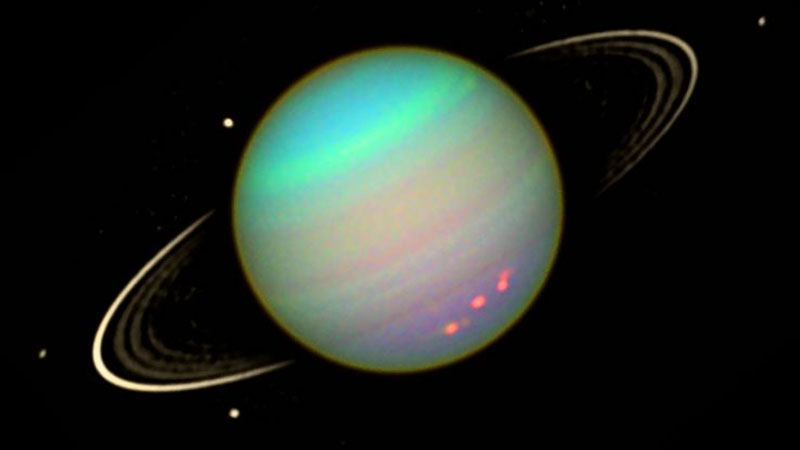One of the promising missions until 2032 is to send a probe to Uranus. Scientists are concerned about the fact that the thermosphere of this planet is rapidly cooling, which has dropped its temperature by half since 1986. This is not observed on any planet in the solar system, and this anomaly requires study. New work by scientists appears to have helped answer this mystery, which may force a change in mission goals.

Artistic representation of the Uranus system. Image source: NASA
An Earth probe has flown close to Uranus only once. This happened in 1986 during the flight of NASA’s Voyager 2. Among other measurements, the automatic interplanetary station estimated the temperature of the thermosphere of Uranus – a region of space at an altitude of up to 50 thousand km above it. Atoms and molecules in the troposphere of Uranus are heated in the same way as particles in the thermosphere of the Earth – due to the energy of ultraviolet radiation from the Sun.
According to the information transmitted by Voyager 2 to Earth, the temperature in the upper layers of the thermosphere of Uranus reached 500 ℃. By the way, in the Earth’s thermosphere, particles heat up to 1500 ℃ and even 2000 ℃. The crew on the ISS is not fried only because the thermosphere is very, very rarefied.
The temperature of the thermosphere of Uranus can also be measured from Earth. Triatomic hydrogen ions freely flying there emit photons in the near-infrared range, freely passing through the atmosphere of our planet and allowing measurements to be made remotely. And such measurements were made regularly and each time they baffled scientists: the thermosphere of Uranus steadily became colder, regardless of the 11-year cycles of solar activity and seasonal changes, so that by today it has become twice as cold as during the flyby of Voyager 2 “
A new study by a team led by Dr Adam Masters from the Department of Physics at Imperial College London provides a reasonable explanation for the temperature anomaly. According to the authors of the work, the temperature of the thermosphere of Uranus is determined by the energy of the solar wind, and not by photons, as is the case with the thermosphere of the Earth.
Since 1990, a constant average decrease in the pressure of the solar wind, represented mainly by solar electrons, protons, atoms and heavy ions, has been recorded. As the authors of the work prove, a decrease in solar wind pressure on the magnetosphere of Uranus causes it to expand and, thereby, affects the temperature of the thermosphere. Under Earth’s conditions (literally an arm’s length from the Sun), this is compensated by the heating of the planet by photons from the star.
The light from the Sun reaches Uranus in a modest amount and cannot affect the heating of its gas shell. Therefore, deprived of the pressure of the solar wind, the gas shell of Uranus expands, and it becomes more difficult for the plasma of the Sun to reach the surface of the planet and transfer its energy to it (heat), which leads to cooling, which is reflected in the cooling of the thermosphere of Uranus.
An interesting practical application of this phenomenon lies in the fact that in this way we can study exoplanets in other stellar systems, drawing conclusions about the magnetospheres of exoplanets and the possibility of the origin of life on them. After all, the magnetosphere is a protection against ionizing radiation. This is what we must look for first of all in order to make correct conclusions about the suitability of planets for biological life.